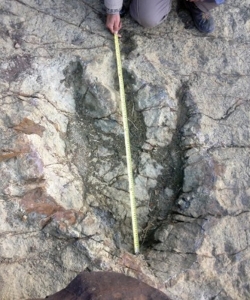A recent discovery has revealed that carnivorous dinosaurs may have been roaming around South America for much longer than we’ve previously believed. A record-setting footprint has recently been discovered in Bolivia. This large footprint measures at 4 feet wide (1.2 meters). At this time, this footprint is considered the largest carnivorous dinosaur footprint to be discovered.
Just last month, a tour guide by the name of Grover Marquina was traveling around the Maragua Crater located 40 miles outside of Sucre, Bolivia. During this particular trip, Marquina stumbled upon a giant footprint that had been buried underneath some boulders.
Paleontologist, Sebastian Apestiguia, has been studying this footprint since its discovery. Apestguia believes that his particular footprint belonged to the biped dinosaur, an Abelisaurus. The Abelisaurus was once a cousin to the more well known dinosaur the Tyrannosaurus Rex. Experts believe that the Abelisaurus roamed around the earth, particularly South America, around 60 to 80 million years ago. There is very little information on the Abelisaurus, the only characteristics that we know come from a partial skull that was found near Lake Pelligrini in Argentine Patagonia.

Photo: History
Although we know little about the Abelisaurus, experts believe that these dinosaurs stood over 40 feet tall. They also believe that these large carnivores had stunted arms just like the T. Rex. This particular footprint stands out among soft clay in Sucre. Aspeteguia comments that, “This print is bigger than any other we have found to date in the area. It is a record in size for carnivorous dinosaurs from the end of the Cretaceous period in South America.”
Breaking records isn’t the only thing this discovery has done. Experts believe that this discovery actually rewrites the timeline of carnivorous dinosaurs that inhabited South America. Before this footprint had been discovered, scientists believed that dinosaurs had actually disappeared by the Late Cretaceous period. As many of you probably already know, many historians believe that the dinosaurs went extinct after the asteroid hit Earth around 66 million years ago. However, this footprint might date back to 80 million years ago, suggesting that some dinosaurs might have stuck around a lot longer than we’d previously believed.


